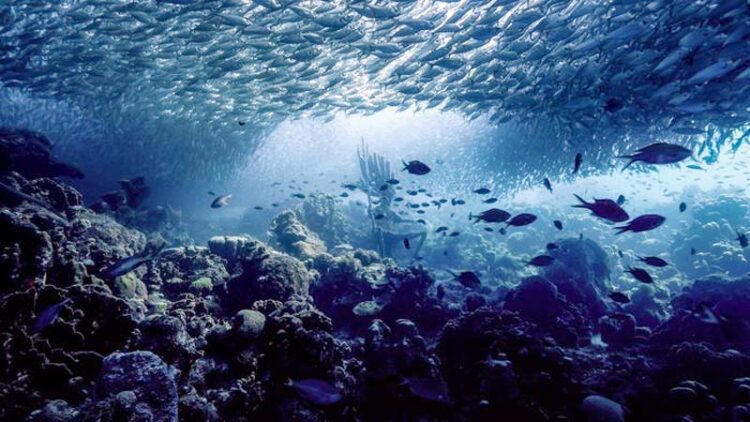Researchers pump brakes on ‘blue acceleration’ harming oceans

Marine image
Credit: The University of Queensland
Protecting the world’s oceans against accelerating damage from human activities could be cheaper and take up less space than previously thought, new research has found.
The University of Queensland’s Professor Anthony Richardson collaborated on the study, which looks to halt the rapid decline of marine biodiversity from expanding industrial activities in marine areas beyond national jurisdictions (ABNJ).
“This ‘blue acceleration’ as we call it, has seen a greater diversity of stakeholders interested in ABNJs, such as the high seas and the international seabed beyond exclusive economic zones,” Professor Richardson said.
“This has led to an issue where current marine protection methods look at each sector separately – such as fishing, shipping, and deep-sea mining industries – all of which have their own suite of impacts on species, communities, and ecosystems.”
In response, researchers assessed the design of different networks of marine protection areas (MPA) across the Indian Ocean that target rich biodiversity areas with minimal impact on profitable human activity.
“Essentially, we assessed the potential trade-offs associated with including multiple stakeholders in a cross-sectoral, as opposed to sector-specific, protected area network, for ABNJs in the Indian Ocean,” Professor Richardson said.
“First, we created three sector-specific plans – involving fishing, shipping, and mining separately – to identify optimal locations for strict, no-take, MPAs.
“We then created a cross-sectoral no-take plan that minimises the opportunity cost to all stakeholders simultaneously, looking at the overall picture with each stakeholder in mind.
“After generating these plans, we compared the three sector-specific solutions, as well as their sum, to the cross sectoral solution.”
Lead researcher from the Royal Belgian Institute of Natural Sciences, Léa Fourchault, said the cross-sectoral approach met the same conservation targets at much lower additional costs for each stakeholder than if all sector-specific plans are implemented without coordination.
“For example, the fishing sector might lose 20 per cent of its potential revenue under the cross-sectoral plan, but it would lose 54 per cent if all sector-specific plans were implemented simultaneously without coordination,” Ms Fourchault said.
“This was consistent for the shipping and mining sectors, with the shipping sector now losing two per cent, instead of 26 per cent of its potential revenue, and the mining sector now losing one per cent instead of close to eight per cent.
“Our results also show that we can reduce the size of MPAs from 25 per cent of the spatial plan to eight per cent while meeting the same conservation objectives.
“This would still achieve 30 per cent coverage for important biodiversity features, including key life-cycle areas for marine megafauna, areas of biological and ecological interest, and areas important to deep-sea ecosystems, such as seamounts, vents, and plateaus.”
Researchers believe the cross-sectoral approach can be a first step to implementing the conservation objectives of the recently signed United Nations High Seas Treaty.
“The code from our research is available online and can be used by scientists, conservationists and politicians alike – and can be applied to any ocean on Earth,” Ms Fourchault said.
“Ultimately, the goal is not only to minimise conflicts between conservationists and multiple industries, but also to ensure marine life is protected against negative cumulative impacts from all three industries simultaneously.”
This research is published in One Earth.
Journal: One Earth
DOI: 10.1016/j.oneear.2023.12.006
Article Title:Generating affordable protection of high seas biodiversity through cross-sectoral spatial planning
Article Publication Date: 10-Jan-2024
All latest news from the category: Ecology, The Environment and Conservation
This complex theme deals primarily with interactions between organisms and the environmental factors that impact them, but to a greater extent between individual inanimate environmental factors.
innovations-report offers informative reports and articles on topics such as climate protection, landscape conservation, ecological systems, wildlife and nature parks and ecosystem efficiency and balance.
Newest articles

Looking inside battery cells
The power of combining different views. Lithium-Ion batteries presently are the ubiquitous source of electrical energy in mobile devices, and the key technology for e-mobility and energy storage. Massive interdisciplinary…

New snail-inspired robot can climb walls
A robot, designed to mimic the motion of a snail, has been developed by researchers at the University of Bristol. Adding to the increasing innovative new ways robots can navigate,…

New technique improves finishing time for 3D printed machine parts
North Carolina State University researchers have demonstrated a technique that allows people who manufacture metal machine parts with 3D printing technologies to conduct automated quality control of manufactured parts during…





















